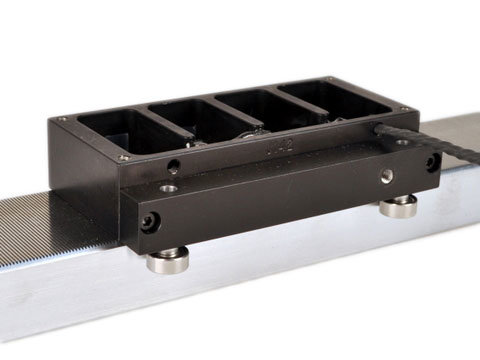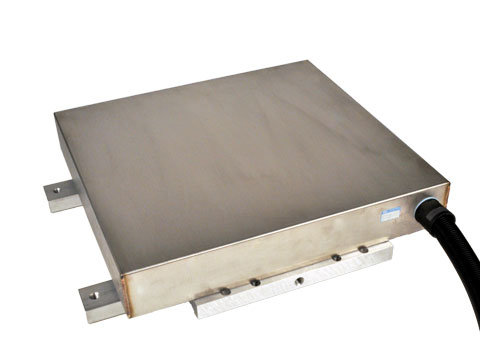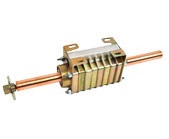What is a Linear Motor?
A linear motor should be thought of as rotary electric motor that has been cut along a radial plane and unrolled. The resultant motor is a direct drive linear electric motor that can produce linear motion without the need of pneumatic, hydraulic cylinders, or translation of rotary to linear motion with the use of belts or screws. Rotary motors produce torque whereas linear motors produce linear force.

Bridging Terminology
|
Rotary |
Linear |
|
Torque (lb-in) or [N-m] |
Force (lbs) or [N] |
|
Velocity (rpm) |
Velocity (in/sec) or [m/sec] |
|
Acceleration (rad/s2) |
Acceleration (in/sec2) or [m/sec2] |
|
Duty Cycle (%) |
Duty Cycle (%) |
Basic Types of Linear Motors
As there are various types of AC and DC rotary type motors, there are also different types of linear motors, which include AC, DC, and Stepper:
* = Max values depend on motor size and bus voltage available. Please contact factory to discuss application requirements.
Brushless
DC brushless linear motors provide non-contact operation for maintenance-free operation. Available in both ironless (cog-free) and iron core versions. They are capable of high speed and high acceleration motion profiles. They can be driven using standard 3 phase brushless servo amplifiers. Brushless linear motors can achieve an acceleration of up to 12 g’s, and speeds in excess of 200+ inches per second [5+ m/s].
Brush
DC brush linear motors are ideal for long stroke, open or closed loop servo, linear motion applications. They can be used at speeds up to 100 in/sec [2.5 m/sec] and as low as 1 in/sec [25 mm/sec]. They are capable of very precise position, velocity, and acceleration control when coupled with a linear encoder.
Voice Coil
DC voice coil actuators are ideal for short stroke (typically less than 2 inches) closed loop servo applications. Their compact size allows them to fit into small spaces. They have very low electrical and mechanical time constants. The low moving mass allows for high accelerations of light payloads. They are available in both moving coil and moving magnet versions.
Linear Stepper
Linear stepper motors are used in both open loop and closed loop positioning applications. Since the positioning is built into the forcer and platen, no additional feedback devices are required which reduces the overall cost of a system. For open loop operation, no servo tuning is necessary. Multiple forcers can operate on a single platen. With linear steppers, acceleration of 1 g and speeds up to 100 in/sec [2.5 m/s] are typical. They are available in both single-axis and dual-axis versions.
Linear Induction
The flat AC linear induction motor (LIM) is typically run directly off of 3 phase line voltage, with an adjustable frequency, or vector drive if speed control is required. Accelerations of up to 1 g with speeds in excess of 1800 inches per second [45 m/s] are possible with LIMs. They are ideal for high speed, long travel applications moving heavy payloads.
Polynoid
The tubular AC linear induction motor (polynoid) is typically run directly off of single or 3 phase line voltage. Accelerations greater than 1 g are possible with polynoids. They are ideal for short stroke, low duty cycle applications. They can be used to replace air cylinders when compressed air is not available.
Force Multipliers Based on Duty Cycle
|
Basic Types of Linear Motors |
Continuous Force/ Motor Area lbs/in2 [N/m2] |
Peak Force/ Motor Area lbs/in2 [N/m2] |
|
AC Linear Motors |
0.2 |
1 |
|
DC Linear Motors |
2.5 |
7.5 |
|
Linear Stepper Motors |
2.5 |
7.5 |
Linear Motor Force
As explained, linear motors produce force (measured in pounds or newtons) along a straight line axis to move its payload. Each motor type provides different force levels.
Force depends upon duty cycle. Duty cycle is specified a percentage:
Linear Motor Advantages
Faster Acceleration: From 1 to 10 g’s; this leads to shortened cycle times and improved productivity for the customer.
High Speeds: Speeds to 1800 inches per second [45 m/sec].
Highly Accurate: Accuracy to 0.00004 in/ft [1 µm/305 mm].
Very Repeatable: Repeatability to 0.00004 inch [1 µm.
No Backlash: A direct drive approach has no backlash such as obtained in leadscrews, gears, belt drives, and pinions.
High Stiffness: Direct drive linear motors provide higher stiffness than ball screw / lead screw systems.
Very Smooth Operation: Linear packages provide smooth operation due to the elimination of mechanical linkages.
Non-Contact Parts: This reduces component friction and wear, thus reducing the customer’s maintenance.
Long Life: Indefinite life expectancy under normal operating conditions can be expected due to the simplicity and part reduction
Low Maintenance: This helps to reduce the customer’s overall costs.
Unlimited Stroke: Stroke lengths are not limited as with ball screws. It is easy to extend the stroke by simply adding another section.









